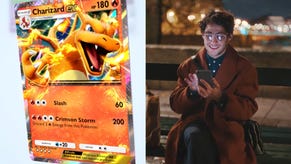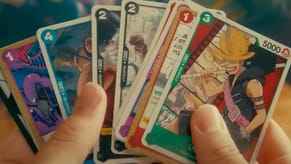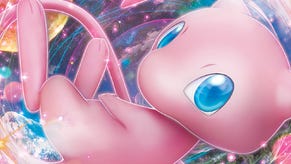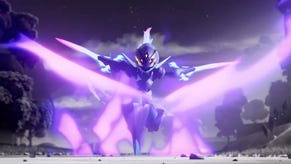Pokémon card types explained: Every type of Energy, Trainer and Pokémon card
From Supporters to Stadiums, EX to GX, here’s how to tell what’s in your deck.
With thousands of Pokémon cards representing hundreds of different Pokémon from throughout the hit series’ history, it’s no surprise that the Pokémon Trading Card Game has a lot of different Pokémon card types for players to get up to speed with.
From the Pokémon themselves - which can vary from the familiar starters and evolutions we all know from the video games through to unique variations and forms only seen in the card game - to the Trainer cards and Energy you’ll use to support your party during battle, knowing the different Pokémon card types is key to going from learning how to play the Pokémon card game to becoming a master trainer.
Pokémon card types
Even if you know your Ghost-type from your Psychic-type, there are plenty of differences between the Pokémon video games and the TCG when it comes to Pokémon card types - so it’s always worth brushing up to make sure your deck is as strong as it can be.
Here you’ll find our guide to every Pokémon card type, exactly what it means and how to use it to its full potential during your next battle. So gather up your Pokémon cards, put those Trainers on speed dial and prepare to be full of Energy as we go through all you need to know.
Main Pokémon card types
There are three main types of Pokémon card in the Pokémon card game. These different cards make up a player’s deck, and represent the Pokémon cards they use to battle their opponent, the Energy cards used to pull off the Pokémon’s most powerful moves and Trainer cards that can represent items, allies, events and even places.
Pokémon cards are the heart of your deck, and are exactly what they sound like: your party of Pokémon. Like in the video games, you can have a mixture of Pokémon across different elemental types to help make the most of your opponent’s weaknesses, or you might specialise in just one or two types if you prefer to channel the spirit of a Pokémon gym leader. Pokémon cards can include Basic Pokémon that can be played directly to your bench, as well as evolved Pokémon stages that are played on top of other Pokémon to evolve them into their advanced forms.
Energy cards are very simple. Each energy card is identical, depending on the type of energy it represents, and can be attached to one of your Pokémon during your turn. Pokémon require specific amounts and types of energy card to perform specific moves and attacks, so you’ll usually have energy cards in the types that match your best Pokémon to make sure you can use them to their full potential.
Trainer cards provide support to your Pokémon during battles. Trainer cards come in many different types, including items, Pokémon Tools, supporters, stadiums, Technical Machines (TMs) and ACE Spec cards, among others. The most common Trainer cards are items, tools, supporters and stadiums. Trainer cards perform a variety of abilities, from drawing extra cards to healing your Pokémon or increasing their attack power. Because of their powerful effects, some Trainer cards limit the player to only playing one of the same type of card, such as a supporter, per turn.
Pokémon card types in Pokémon TCG
Within the Pokémon card game there are a number of different Pokémon card types that can apply to the Pokémon in your deck. Largely unrelated to the rarity of a specific card (although the two can go hand-in-hand), these Pokémon card types instead represent different versions of Pokémon in the game’s world - from their basic starting forms to later evolutionary stages and even immensely powerful Mega Evolutions and other variants.
Basic Pokémon: Basic Pokémon are often the first Pokémon cards you play, representing Pokémon that do not need to evolve from other Pokémon to be played directly onto the field as an active or benched Pokémon. Some Basic Pokémon can evolve into Stage 1 Pokémon or other evolutions depending on the specific card, but some do not evolve.
Stage 1 Pokémon: Stage 1 Pokémon cards represent the first stage of evolution from a Basic Pokémon. They are played on top of the corresponding Basic Pokémon (or Fossil Trainer cards treated as Basic Pokémon, in some cases). In most cases, Pokémon can’t evolve on the same turn they’re played (or the first turn of the game) and retain any damage counters (but not status effects), energy cards and Pokémon Tools from the previous card.
Stage 2 Pokémon: Stage 2 Pokémon cards work in a very similar way to Stage 1 Pokémon, being the next evolutionary step of a Pokémon played on top of the corresponding card. Stage 1 Pokémon cannot evolve into Stage 2 Pokémon on the same turn they evolve from a Basic Pokémon, but some Item cards - such as Rare Candy - can evolve a Basic Pokémon into a Stage 2 card without needing to play a Stage 1 Pokémon.
Baby Pokémon: Introduced in 2000’s Neo Genesis expansion, Baby Pokémon served as a pre-evolution of some Basic Pokémon, allowing them to be played directly to the field and evolve into Basic Pokémon (which usually do not require an evolution to be played). Later versions of Baby Pokémon cards instead made them Basic Pokémon cards with a Baby Evolution ability, allowing them to evolve while removing damage. However, they then lost the power to evolve; in recent sets, Baby Pokémon largely appear and function as standard Basic Pokémon, often having one simple attack that costs no energy and an ability that relies on a coin flip to decide its outcome.
Shining Pokémon: Shining Pokémon cards are the TCG’s equivalent to shiny Pokémon in the video games. The first Shining Pokémon cards to be introduced were Magikarp and Gyarados, appearing as extremely rare Pokémon cards in the Neo Revelation expansion. As well as having unique artwork based on the shiny Pokémon’s alternative appearances, Shining Pokémon cards have different attacks and stats compared to their standard forms. Due to their increased power, despite being Basic Pokémon, Shining Pokémon were originally restricted to a single copy of each card in a player’s deck. This has been changed in more recent releases from Sun & Moon onwards, with the power level of Shining Pokémon’s attacks adjusted accordingly.

Pokémon-ex: Introduced in the titular Pokémon EX series of expansions, Pokémon-ex represent more powerful versions of Pokémon seen on other cards - with the “ex” after the card’s name being short for “extra”. The increased power often translates to greater HP and more damage output than their standard versions, along with the addition of new moves. However, that power comes at a risk; if a Pokémon-ex card is knocked out, the player’s opponent claims two prize cards. After last appearing in 2007 expansion EX Power Keepers, Pokémon-ex were resurrected as Pokémon ex over 15 years later during the Scarlet & Violet series.
Pokémon ex: A reboot of the Pokémon-ex type from the EX series, Pokémon ex (note the missing hyphen!) appeared in the Scarlet & Violet series in 2023. Like Pokémon-ex Pokémon ex cards feature variants of Pokémon with increased HP, greater damage and new moves compared to their standard versions. When a Pokémon ex is defeated, the player’s opponent claims two prize cards. A further variant introduced during Scarlet & Violet, Tera Pokémon ex, feature Terastallized Pokémon with a crystallised appearance in their artwork, potentially different types from the standard card and cannot take any damage while on the player’s bench.
Pokémon-EX: First seen in Black & White - Next Destinies, Pokémon-EX are a separate type of Pokémon card from Pokémon-ex or Pokémon ex, but have similar attributes in having much greater HP than the Pokémon’s standard card and awarding two prize cards when defeated in return. From the XY expansion onwards, some Pokémon-EX cards can evolve into M-Pokémon-EX - bringing the Mega Evolutions seen in the X and Y video games to the TCG.
Pokémon-GX: Pokémon-GX are a variant of the earlier Pokémon-ex ,ex and -EX cards, appearing during the Sun & Moon series of expansions. Like the ex family of cards, Pokémon-GX feature increased health and damage compared to their Pokémon’s standard forms, but with the risk that your opponent can draw one extra prize card when defeated. What makes Pokémon-GX different to the ex cards is the introduction of GX attacks, inspired by the powerful Z-Moves in video games Pokémon Sun and Moon. Due to their extreme power, only one GX attack can be used by each player per game. A further variant, TAG TEAM Pokémon-GX, was introduced in the Team Up set, featuring two or more Pokémon on a single card - and more HP than their solo GX counterparts accordingly, along with attacks that can be boosted by attaching additional energy cards as stated by their rules. However, when a TAG TEAM Pokémon-GX card is knocked out, the opponent claims three prize cards as a reward.
Pokémon V: Pokémon V are another successor to Pokémon-ex, ex and EX, representing variants of Pokémon that boast increased health and strength compared to their regular forms - as well as increased rewards when defeated. Pokémon V appear in a number of versions, including Pokémon VMAX - representing the supersized Dynamax, Gigantamax and Eternamax Pokémon seen in the Sword and Shield video games - which award three prize cards in return for even mightier power; Pokémon V-UNION, formed of four separate cards depicting a group of Pokémon that have a greater number of attacks and also reward three prize cards when knocked out; and Pokémon VSTAR, an evolution of Pokémon V with VSTAR Power abilities that can only be used once per game due to their strength.
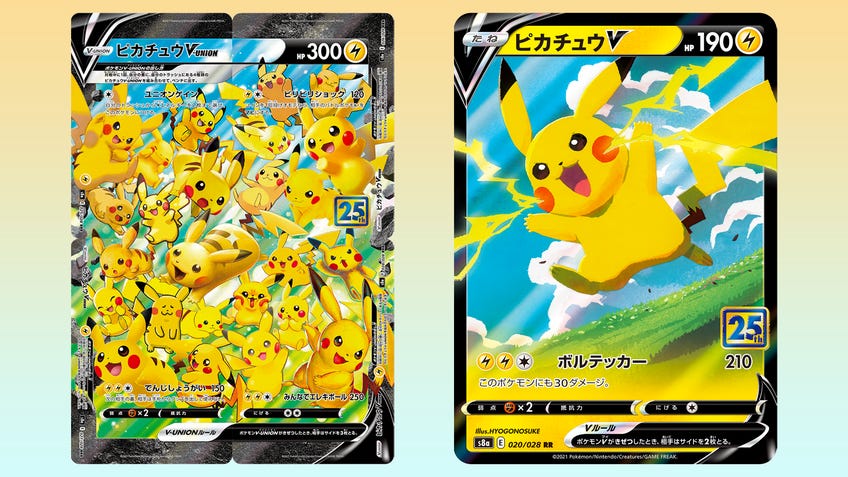
Pokémon Lv.X: Appearing from 2007’s Diamond & Pearl expansion through to the Arceus set in 2009, Pokémon Lv.X represent Pokémon trained to a higher level - just as they can be levelled-up in the video games. Level-Up cards must be played onto the corresponding Pokémon like evolution cards (though, in one rule change, it must be the active Pokémon), allowing for a variant of the Pokémon with greater HP, damage and additional attacks - as well as being able to use the moves of the card from which they levelled-up, unlike evolutions. While similar to Pokémon-ex, ex and -EX cards in terms of being more powerful variants of other Pokémon, Lv.X cards do not grant two prize cards when defeated. Lv.X cards were later succeeded by Pokémon LEGEND cards and Pokémon-EX.
Pokémon SP: With SP standing for “Special Pokémon”, Pokémon SP represent Pokémon belonging to specific trainers and groups within the world of Pokémon. As such, Pokémon SP have a symbol representing different variants: 4 (for the Elite Four), C (for Champions), FB (for Frontier Brains), G (for Team Galactic), GL (for Gym Leaders) and M (for Movie, meaning 2009 animated film Pokémon: Arceus and the Jewel of Life). Pokémon SP are usually Pokémon Lv.X cards or Basic Pokémon.
Pokémon LEGEND: As the name suggests, Pokémon LEGEND cards exclusively feature Legendary Pokémon from the TCG. Alongside Pokémon-EX cards, they replaced Lv.X cards for Legendary Pokémon during the HeartGold & SoulSilver series of expansions. Pokémon LEGEND cards are unique in several ways. They are the only Pokémon card type to have the LEGEND evolution stage, meaning they cannot be played at the start of the game like Basic Pokémon nor evolved like other Pokémon cards. Pokémon LEGEND cards are also made up of two separate cards, which must be played to the bench at the same time to form a single Legendary Pokémon (treated as one card from then on). Later LEGEND cards featured two Legendary Pokémon on the same card, which awarded two prize cards when defeated.
Restored Pokémon: Restored Pokémon cards represent Pokémon resurrected from fossils, similar to the ancient Pokémon found in the video games. To restore a Pokémon, the player must first play the corresponding Fossil Trainer card - which is treated as a Basic Pokémon and played to the bench. The Fossil card can then be searched to search the bottom seven cards of the player’s deck for the matching Restored Pokémon; if they are successful, the Pokémon can be played to their bench.
Pokémon BREAK: Introduced in the eponymous BREAKthrough expansion in 2015 and appearing until XY - Evolutions in 2016, Pokémon BREAK cards serve as an alternative evolution option for certain Pokémon. When played to their corresponding Pokémon, the cards are oriented horizontally - covering the previous card’s artwork and HP, but not its attacks, abilities and other traits left visible, which remain available and in play. Pokémon BREAK provides increased HP and additional moves to their matching Pokémon - similar to Lv.X and EX cards, but without the downside of your opponent drawing an extra prize card when knocked out.
Prism Star Pokémon: Prism Star Pokémon were a short-lived type of Pokémon card (and, in Lost Thunder, Stadium Trainer cards) that appeared from Sun & Moon - Ultra Prism in 2018 through to Team Up the following year. Denoted by a rainbow prism icon and a rainbow effect applied to the card’s artwork, Prism Star cards are limited to a single copy of each specific Prism Star card - but can be included alongside the standard maximum limit of a Pokémon of the same name. When Prism Star cards are discarded - for instance, when knocked out - they are sent to the Lost Zone, effectively removing them from the game.
Energy types in Pokémon TCG
There are currently 11 energy types in the Pokémon card game. These are similar to the different Pokémon types seen in the video games, but with a number of Pokémon types from the video games combined into single types for the TCG.
Pokémon can have one or more types, which can affect their weakness and resistance against Pokémon of related types, causing them to take increased or decreased damage from attacks. A Pokémon’s resistance or weakness is determined by the type of the Pokémon attacking it, not the specific attack being used.
There were originally seven energy types in the Pokémon TCG: Colourless, Fighting, Fire, Grass, Lightning, Psychic and Water. Darkness and Metal types were added in the 2000 Neo Genesis set, with Dragon-type Pokémon introduced in 2012’s Black & White - Dragons Exalted set and Fairy-type Pokémon and energy introduced in the XY series in 2013.
While Fairy-type cards remain in the card game, as of the Sword & Shield expansion in 2020 they are now counted as part of the Psychic type, rather than a separate type on their own. Fairy energy cards are no longer legal to play in official Pokémon TCG tournaments, rotating out of the Standard format as of September 2021 - the first energy type to be removed from the TCG.
Here are the 11 energy types in the Pokémon card game:
Colourless: Colourless energy is a unique type in that moves requiring Colourless energy may use energy of any other type instead - there is no basic Colourless energy card, outside of Special Energy cards. The Colourless type in the Pokémon TCG includes Normal, Flying and Dragon Pokémon seen in the video games, although more recent Dragon cards - from 2012’s Dragons Exalted expansion onwards - have been classified as their own separate type of Pokémon card. Colourless Pokémon can be weak to Lightning, Fighting or other Colourless-type Pokémon, depending on if they are also a Flying, Normal or Dragon-type Pokémon. They may have resistance to Psychic, Fighting, Fire, Grass or Water-types, depending on if they are a Normal, Flying or Dragon-type Pokémon (and the specific card). Colourless Pokémon are usually strong against other Colourless Dragon Pokémon.
Darkness: Darkness was added to the Pokémon card game in 2000’s Neo Genesis set, reflecting the introduction of Dark-type Pokémon in the Pokémon Gold and Silver video games. As well as including Dark-type Pokémon, it has inherited Poison-type Pokémon from the Sword & Shield expansions onwards, having previously appeared under the Grass type. Darkness Energy cards were originally only Special Energy cards, with basic Darkness Energy added years later in 2007’s Diamond & Pearl expansion. Darkness Pokémon can be weak to Fighting and Grass-type Pokémon, depending on whether they are also Dark or Poison-types and the specific card. Darkness Pokémon are typically resistant to Psychic Pokémon, and strong against Psychic Pokémon.
Dragon: Dragon is the most recent energy type to be introduced to the Pokémon TCG and still officially supported (after Fairy was removed in 2020). Dragon-type Pokémon were included as Colourless Pokémon cards until 2012’s Dragons Exalted expansion, where they were granted their own distinct type in the card game. Dragon is the only Pokémon type that doesn’t have a basic energy card; Double Dragon Energy is a Special Energy card that can only be attached to Dragon Pokémon and provides every type of energy while attached, but only two energy at a time. As such, Dragon Pokémon often require other energy types to perform their moves. Dragon Pokémon cards are typically weak to other Dragon Pokémon and Fairy Pokémon, while being strong against other Dragon Pokémon.
Fairy: Fairy is both the most recent energy type to be introduced to the Pokémon TCG, added during the XY series in 2013, and the only energy type to be officially removed from the card game to date, as of the Sword & Shield expansion in 2020. Representing Fairy-type Pokémon from the video games - many of which had appeared as Colourless-type cards before XY - the Fairy type was weak against Metal, resistant to Darkness and strong against Dragon-types. From Sword & Shield onwards, Fairy-type Pokémon are now included as part of the Psychic type. In 2021, Fairy Energy became the first basic energy card to be rotated out of the Standard format, becoming illegal to play in official tournaments.
Fighting: One of the original seven types in the Pokémon card game, Fighting represents Fighting, Rock and Ground-type Pokémon seen in the video games. Depending on the Pokémon’s type in the video game, Fighting Pokémon cards may be weak against Psychic, Grass or Water, while usually being resistant to Lightning if they’re a Ground-type. On the flipside, Fighting Pokémon are often strong against Darkness, Colourless and Lightning Pokémon.
Fire: Another energy type that has been in the Pokémon card game from its very first set, Fire is also one of very few Pokémon energy types in the TCG that only represents a single type in the video games: Fire, of course! Like the video games, Fire Pokémon are usually weak to Water-types, while being strong against Grass or Metal Pokémon.
Grass: Joining the original line-up of types in the Pokémon TCG Base Set, Grass represented a combination of Grass, Poison and Bug Pokémon from the video games. Since then, Poison-types have been regrouped under the Darkness type (after being Psychic-types for over a decade from Diamond & Pearl in 2007 to Sword & Shield in 2020). As any Bulbasaur fan knows, Grass-types are normally weak against Fire if they’re a Grass or Bug Pokémon, with older Poison Pokémon cards often being weak against Psychic. They’re commonly resistant to Fighting and Water - depending on if they’re a Bug, Poison or Grass-type respectively - while also typically being strong against Water, Fighting and Darkness Pokémon .
Lightning: Lighting is another one of the original seven energy types found in the Pokémon card game, representing Electric-type Pokémon from the video games - notably, Pikachu and friends. In keeping with the video games, Lightning Pokémon cards are often weak to Fighting-types and even other Lightning-types, if the Pokémon is a Flying-type such as Zapdos. However, Flying-types can also be resistant against Fighting Pokémon, with other Lightning Pokémon often resistant to Metal Pokémon. As you’d expect, Lighting Pokémon are strong against Water-types and Flying-types.
Psychic: Psychic is one of the busiest energy types in the Pokémon TCG, currently representing three different types from the video games - Psychic, Ghost and Fairy - and having previously included some Poison Pokémon, too. When it was included in the card game’s earliest sets, Psychic simply represented Psychic and Ghost Pokémon. From the Diamond & Pearl expansion in 2007 until Sword & Shield in 2020, Poison Pokémon were moved across from being Grass-types to being Psychic-types; nowadays, they are grouped with Darkness Pokémon. However, the Psychic category gained a different type at the same time, inheriting Fairy Pokémon cards as they were downgraded from having their own separate type. If that wasn’t enough, Psychic Pokémon have also seen their weaknesses changed; originally weak to other Psychic-types, Sword & Shield updated this so Psychic and Ghost Pokémon became weak to Darkness. As a result, Psychic Pokémon can be weak to Darkness, Psychic or Metal, depending on whether it’s a Psychic, Ghost or Fairy Pokémon. They’re typically resistant to Fighting or Colourless if the Pokémon is a Ghost-type, depending on the card, with Psychic cards often being strong against Grass, Fighting and other Psychic Pokémon.
Water: Another of the original seven energy types found in the Pokémon card game, Water represents both Water and Ice Pokémon from the video games. Squirtle fans, assemble! Like the video games, Water Pokémon are usually weak against Grass or Lightning, while Ice Pokémon are often weak against Fighting or Metal. However, they’re typically strong against Fire-types and Fighting-types.
Trainer card types in Pokémon TCG
Item: Item Trainer cards are among the most common Trainer cards. They typically offer a single effect performed by playing and discarding the item. The effect depends on the item, but examples include searching your deck for a specific card - as with the Poké Ball item - or healing damage from your Pokémon, as with a potion. Each player can play as many item cards as they like during their turn.
Supporter: Behind items, Supporters are some of the most common Trainer cards in the Pokémon TCG. These cards typically represent characters and allies from the world of Pokémon - including the video games and anime TV show - that can provide aid to a player. Each card has a different effect depending on the character, and most support cards are discarded once played. Due to the powerful effects of Supporter cards, players can only play one Supporter card per turn and the first player can’t play a Supporter on their opening turn.
Pokémon Tool: Pokémon Tool cards are a later version of item Trainer cards, first seen in the Neo Genesis set. They were categorised as item cards up to the Scarlet & Violet series of expansions, where they became a distinct type of Trainer card. Whereas normal item cards are usually discarded after use, Pokémon Tools are often attached to a Pokémon on the field, providing an ongoing effect - such as increased power, the ability to use a new move or an effect triggered by a specific action. Players can play as many Pokémon Tool cards as they like during their turn, but each Pokémon can only have one Tool equipped at a time in most cases.
Stadium: While Pokémon battles can happen anywhere - as anyone who’s ventured into tall grass can tell you - Stadium Pokémon cards represent specific places where trainers are battling. Stadium cards introduce ongoing effects that reflect the environment they depict, from allowing additional card draw to affecting the energy cost of specific actions, often affecting both players equally. Only a single Stadium card can be active at any one time, with the current Stadium replaced when another card is played - it must have a different name to the current Stadium, too. Like Supporter cards, players can only play a single Stadium card on their turn. While Stadium cards became their own category of Pokémon card for a few years, they are currently considered a type of Trainer card.
Technical Machine: Like their counterparts of the same name in the Pokémon video games, Technical Machine cards can be attached to Pokémon to grant them new abilities and attacks. While Technical Machines were their own category of Trainer card for almost a decade up to 2009’s Rising Rivals set, following a 14-year gap with no new Technical Machine cards they were reintroduced as Pokémon Tool cards in the Scarlet & Violet series of expansions.
ACE SPEC: ACE SPEC are among the most powerful Trainer cards in the Pokémon card game, with players restricted to a single ACE SPEC card in their entire deck. ACE SPEC are a subcategory of other Trainer card types; ACE SPEC cards can be Pokémon Tools, Items or Special Energy cards, offering even more powerful effects when attached to a Pokémon or used for an instant effect. Examples include the iconic Master Ball - allowing a player to put any Pokémon from their deck into their hand - and Gold Potion, which heals 90 HP from the active Pokémon. After a decade out of the card game, ACE SPEC cards were reintroduced in Japanese Scarlet & Violet expansions Wild Force and Cyber Judge (released in English as Temporal Forces), which also introduced the first ACE SPEC Special Energy card, Neo Upper Energy.
Rocket’s Secret Machine: Named for the villainous Team Rocket, Rocket’s Secret Machine cards are a rarely-seen type of Trainer card. To date, fewer than a dozen Rocket’s Secret Machine cards have been released, with the last appearing in 2004 expansion EX Team Rocket Returns. While technically a distinct type of Trainer card, Rocket’s Secret Machine cards function like standard Item cards, being discarded for a specific effect.
Goldenrod Game Corner: Only two Pokémon cards to date have been Goldenrod Game Corner Trainer cards: Arcade Game and Card-Flip Game, both of which appeared in 2000 expansion Neo Genesis (Gold, Silver, to a New World… in Japan). The two cards are inspired by the Goldenrod Game Corner from Pokémon Gold and Silver’s region of Johto, and trigger luck-based effects when used. Otherwise, they work just like normal Item cards.




